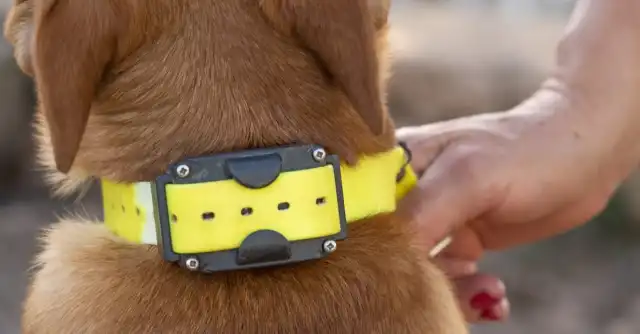A training collar, also known as an electronic, remote, or shock collar, is a type of collar used to train dogs. It is an effective tool that can be used to address certain behavioral issues, teach basic obedience commands, and reinforce positive behavior. Training collars come in different types, such as flat collars, prong collars, and spray collars. Although these collars have received criticism from some pet parents when used properly, they can be a valuable part of a comprehensive training program to help furry friends become the best they can be.
Types of Training Collars
Training collars are an essential tool when it comes to correcting undesirable behavior in dogs. They work by delivering a stimulus, such as vibration, sound, or shock, to the dog’s collar, which can help to reinforce positive behavior or deter undesirable behavior.
There are several types of training collars available in the market, each with its unique features and suitability. The following is an overview of the most common types of training collars:
1. Flat Collar
Flat collars are the most basic and common type of dog collar. They are made of nylon or leather and have a buckle or snap that makes it easy to put them on and take them off. Flat collars are primarily used for holding identification tags, but they can also be used for basic obedience training. They are lightweight and comfortable, making them perfect for everyday wear.
2. Chain Slip Collar
Chain slip collars are also known as choke collars, and they are designed to tighten around the dog’s neck when the leash is pulled. They are ideal for training dogs to heel and walk correctly on a leash, but they must be used with caution. Chain slip collars can cause injury or even death when misused.
3. Martingale Collar
Martingale collars are limited-slip collars designed to prevent dogs from slipping out of their collars. They consist of a length of material with a metal ring at each end and a smaller loop that runs through the collar’s main loop. When the dog pulls, the smaller loop tightens the main loop, preventing the dog from escaping. Martingale collars are ideal for dogs with narrow heads, such as greyhounds and whippets.
4. Prong Collar
Prong collars have metal prongs that rest against the dog’s neck, and they are designed to apply pressure evenly around the neck when the leash is pulled. They are ideal for training dogs to walk on a leash without pulling. Prong collars must be used with caution as they can cause injury, and they are not suitable for all dogs.
5. Remote Training Collar
Remote training collars, also known as e-collars, are designed to deliver a stimulus, such as vibration, sound, or shock, to the dog’s collar from a distance. They are ideal for correcting unwanted behaviors, such as excessive barking or jumping, and reinforcing positive behaviors. Remote training collars are suitable for dogs of all sizes, but they must be used with caution to avoid causing undue stress or harm to the dog.
Benefits of Using a Training Collar
A training collar can be an effective tool to help you train your furry friend by providing consistent and reliable feedback during training sessions. By using a training collar, you can enhance communication between you and your pet, which helps create a positive relationship based on reduced stress.
Another benefit of using a training collar is that it can give your dog the freedom to be off-leash while still maintaining control. This allows your dog to have more space to exercise and explore, while you have peace of mind knowing that you have control over your pet’s behavior.
Training collars are also great for correcting unwanted behaviors immediately after they occur. This is because the collar provides a quick and efficient way to apply corrective measures, such as a vibration or sound, to let your dog know that their behavior is not acceptable.
Lastly, training collars are beneficial for working at longer distances. This is because they allow you to communicate with your dog even when you are far away from them. This is especially useful when you are training your furry friend for a specific task, such as search and rescue.

Preparing to Use a Training Collar
Preparing to use a training collar is an important step in ensuring that the collar is used effectively and safely. Before using a training collar, it is important to assess your dog’s behavior and determine what type of collar is appropriate for your pet. Additionally, it is important to properly fit and adjust the collar to ensure it is comfortable for your pet and provides effective stimulation. By following these steps, you can help ensure that your training sessions are successful and positive for both you and your furry friend.
Selecting the Right Type of Collar for Your Dog
When it comes to choosing the right collar for your dog, there are a variety of types to consider. Each type of collar has its unique purpose, so selecting the right one for your furry friend is important to ensure their safety and comfort.
One of the most common types of collars is the flat collar. These are perfect for everyday use and come in a wide range of materials, such as nylon and leather. Flat collars are adjustable and typically feature a buckle or snap closure. They are a great option for dogs who do not have any specific behavior issues and simply need to wear a collar for identification purposes.
Martingale collars are another type of collar that can be used for everyday wear, but they are particularly useful for dogs that tend to slip out of their collars. These collars are made up of two loops — one that goes around the dog’s neck and another that tightens when the dog pulls. As a result, it’s nearly impossible for them to wiggle their way out of the collar.
For dogs with a high prey drive, prong collars and pinch collars may be the best option. These collars have metal prongs or spikes that, when used correctly, can provide effective control over your dog’s behavior. It’s important to note, however, that these collars should only be used under the guidance of a professional dog trainer.
Shock collars, also known as electronic collars, can be used for behavior modification but should only be used as a last resort and under the guidance of a professional trainer. These collars deliver a small electric shock to the dog when triggered by the owner using a remote control. They are adjustable and typically have multiple levels of stimulation, allowing for customization based on the dog’s behavior.
When choosing a collar for your dog, it’s important to consider their breed, temperament, and behavior. While flat collars are suitable for most dogs, certain breeds and personalities may require a more specialized collar. Ultimately, the goal of any collar should be to ensure your dog’s comfort and safety while also providing effective control.
Choosing the Correct Size and Fit of the Collar
Choosing the correct size and fit of a training collar for your furry friend is crucial to their safety and comfort. A well-fitting collar is not only important for everyday use but is also crucial for successful electronic training and avoiding injuries.
A collar that is too loose may fall off and get lost while one that is too tight could cause wounds, make your dog uncomfortable, and negatively affect behavior modification. Therefore, always measure your dog’s neck before purchasing a training collar to accurately select the correct size.
It’s important to choose an accurate collar size that fits your dog’s neck without being too loose or too tight. A good rule of thumb to follow is the two-finger rule. Make sure the collar leaves room for a maximum of two fingers to fit between it and your dog’s neck. This ensures the collar is not too tight, but also not too loose that it doesn’t properly hold the training device in place.
When you receive the collar for your dog, ensure that it is properly adjusted for its neck size and comfort. A well-fitting collar ensures that the training device works efficiently and allows you to train your dog effectively without causing any discomfort or harm.
Assessing Unwanted Behaviors in Your Dog
How to use a training collar? Before using a training collar on your dog, it is crucial to assess their behavior to identify any unwanted or undesirable behavior. Understanding the root cause of the behavior is crucial before embarking on any behavior modification techniques. There are several factors you should consider when assessing your dog’s behavior, including their age, temperament, and past experiences.
Start by observing your dog’s behavior in various situations and identifying any triggers that may cause the behavior to occur. For instance, if your dog barks excessively, you may need to observe them in situations where they tend to bark, such as when someone rings the doorbell or when you arrive home. Identifying the trigger will provide you with insight into the root cause of the behavior.
Assessing your dog’s behavior requires patience and consistency. Take time to monitor your dog’s behavior every day and record any undesirable behavior you note. This process will help you establish patterns in your dog’s behavior, which can help you identify the root cause.
Take into account your dog’s age and temperament when assessing their behavior. Puppies and senior dogs may require different types of training when correcting bad behavior. Some behaviors, such as fear or aggression, may require a more complex approach than a professional dog trainer can provide.
Consulting with a professional dog trainer can also help you determine the best approach to modifying your dog’s behavior. They can provide you with professional advice and training techniques that can help you address the behavior effectively.
Setting Up the Training Environment for Successful Results
Setting up the training environment is crucial when it comes to getting successful results from your dog’s training sessions. A positive and distraction-free training space helps your furry friend focus and understand what you expect of them. Follow these tips to create a successful training environment.
Designate a specific area: Choosing a specific area for training sessions is essential. This space should be free from any distractions or disturbances that could interrupt your session. Whether you are training indoors or outdoors, choose a space that your dog can associate with the training process.
Gather necessary training tools: Collect all necessary training tools before you begin a session. These may include treats, toys, clickers, and anything else that you may need. Positive reinforcement training is essential, so ensure that you have plenty of rewards on hand to reinforce good behavior.
Introduce specific commands and activities: Before you begin each session, introduce specific commands and activities that you will be working on. Use clear and concise language to help your dog understand what you expect of them. Teach your furry friend tricks and basic obedience commands to enhance their understanding and focus.
Identify potential barriers: Identify any potential barriers that may hinder your training sessions’ success. These barriers may include health factors, outdoor conditions, or any other factor that may affect your dog’s behavior. Once you identify these barriers, you can take steps to address them and minimize their impact on your training sessions.
Using the Training Collar Properly and Effectively
Using a training collar can be an effective tool to modify your dog’s behavior, but it is important to use it properly to ensure that it is both safe and effective. In this article, we’ll provide guidelines and tips to help pet parents use training collars properly and effectively. From selecting the right type of collar to properly fitting and using it, we’ll cover everything you need to know to get started.

Following Basic Commands with the Remote Control or Stimulation Button
Training your dog to follow basic commands can be a challenging task. Fortunately, with the help of remote control or stimulation button training collars, the process can be a lot simpler. Here’s a step-by-step guide on how to follow basic commands using a remote control or stimulation button:
Step 1: Set the Initial Training Level
Start by setting the initial training level on the remote control. Check the manufacturer’s manual for specific instructions on how to set this feature up. Once you have set the initial training level, tap the stimulation button at the lowest level that gets your dog’s attention without scaring them.
Step 2: Use Treat Rewards
Rewarding good behavior is key to making sure your furry friend learns to follow commands. To teach good behavior, use treatment rewards. Have a treat in your other hand to reward good behavior immediately.
Step 3: Follow Specific Commands
To teach your dog to follow specific commands, such as “sit” or “bed,” follow these steps:
– For “sit,” verbalize the command while activating the tone, vibration, or static stimulation button on your remote and hold a treat just above his nose. Once he sits, give him the treat.
– For “bed,” lead your dog to his designated spot while administering stimulation and say the command. Once in his designated spot, give him a treat to reward him.
– For a voiceless “come,” ask your dog to sit and call him to you while pushing the vibration or tone button. Once he comes to you, reward him with a treat.
– For an off-leash “heel,” push the static button and pull your dog to your side while instructing him to “heel.” Remove the stimulation once he follows, then give him a treat to reward his good behavior.
Step 4: Use Appropriate Stimulation
Pay attention to your dog’s behavior when using the tone, vibration, or static stimulation button. Be careful not to overstimulate your pet and only use the appropriate level of stimulation to correct undesirable behavior.
Lowest Level Settings for Behavior Modification Techniques
When it comes to using a training collar for behavior modification, it is crucial to choose the lowest level settings possible. This not only ensures your pet’s safety but also increases the effectiveness of training.
To begin, it is important to determine the lowest level of static stimulation that will get your dog’s attention. Gradually increase the stimulation while your pet explores the training area until he responds with a head tilt or other signal. This helps you identify the minimum level that will work for your dog without causing harm.
When using the training collar for behavior modification, be sure to set it to the lowest level and momentary mode. Momentary mode ensures that the stimulation is delivered for only a brief period. This helps to prevent overstimulation and harm to your dog.
Avoid the temptation to increase the level of your dog’s yelps or jumps during training. Doing so can cause physical harm and reduce the effectiveness of the technique. Instead, stick to the lowest level and focus on other positive reinforcement strategies to encourage good behavior.
Avoiding Excessive Barking with Remote and Spray Collars
Excessive barking in dogs can be a nuisance and disrupt peaceful living conditions for both you and your neighbors. Thankfully, remote and spray collars can help curb this behavior effectively.
Remote collars function by sending a stimulation or vibration signal to your dog when they bark excessively. Whereas, the spray collars release a scent, such as citronella, when triggered by your dog’s barking. Both types of collars have adjustable levels of stimulation or spray to suit your dog’s recognition level.
However, before using any of the collars, it’s crucial to select the appropriate level of stimulation or spray for your furry friend. It’d be best to start at the lowest level and gradually increase until your dog responds to the signal. It’s important to do this in a controlled environment where your pet can concentrate on the training and avoid distractions that might affect their response.
A proper introduction to the collar is key in ensuring your pet’s positive response to the collaboration. Always start by wearing the collar on your dog without activating it. Positive reinforcement, such as treats and praises, will encourage your pet to see the collar as a positive training tool.
When your dog has adapted to the collar, introduce the stimulation or spray in a controlled, positive manner. Always monitor your pet’s response to the signal and adjust the level as necessary. Be patient and consistent in your training, as it may take time for your furry friend to respond, so don’t give up too soon.
Professional Assistance from a Pet Trainer if Necessary
Using a training collar is not always a straightforward process. Despite having selected the appropriate collar type and size, you may still encounter issues when training your furry friend. It’s essential to recognize that undesirable behavior may persist and it may be necessary to seek assistance from a professional dog trainer.
If you’re experiencing any difficulties when using a training collar on your dog, don’t hesitate to look for professional assistance. A qualified Certified Dog Behaviorist who is familiar with various dog training tools and techniques will be able to provide the necessary guidance and support to ensure effective training.
A professional pet trainer will also be able to identify the underlying cause of your dog’s behavior and create a customized training plan catered to your furry friend’s needs. This approach will help ensure that your dog responds to the training and is comfortable wearing the training collar.
Remember, it’s crucial to be patient and consistent when training your dog, but if you’re struggling to train your furry friend effectively, a professional dog trainer can help. Don’t hesitate to reach out to a professional for assistance in creating a customized training plan that will address your dog’s specific needs.
Conclusion
In conclusion, using a training collar can be an effective way to correct undesirable behavior in your dog, but it’s important to use the collar correctly and in conjunction with positive reinforcement techniques. Prioritizing your dog’s well-being and happiness and seeking professional assistance when necessary can help make the training process effective and enjoyable for both you and your furry friend.





